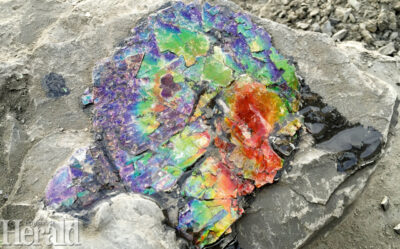Piikani Chief comes full circle with Buffalo Stone
By Alexandra Noad - Lethbridge Herald Local Journalism Initiative Reporter on July 10, 2024.
 Herald file photo
Buffalo Stone (iiniskim) commonly known in English as ammolite, is an iridescent gemstone which comes from the fossil ammonite.
Herald file photo
Buffalo Stone (iiniskim) commonly known in English as ammolite, is an iridescent gemstone which comes from the fossil ammonite.Before white settlers arrived on the plains, southern Alberta was home to the Blackfoot people. They relied on the buffalo for all of their needs from food to shelter to clothing. Blackfoot people had a sacred relationship to the land and often shared stories with each other.
One of these stories which has been passed down many generations is the Buffalo Stone (iiniskim) commonly known in English as ammolite. Ammolite is a gemstone which comes from the fossil ammonite.
Thousands of years ago during a severe drought the Blackfoot hunters were unsuccessful at catching any buffalo for months, despite their greatest efforts.
One night a young lady had a dream where a spirit came to her and said “Creator has heard your pleas and prayers for assistance. I am going to give you a very special stone. It’s called iiniskim- the Buffalo Stone.”
The spirit taught her the songs, prayers and the ceremony for the Buffalo Stone, which would bring prosperity to the Blackfoot people.
When the woman awoke she told her husband about the dream and then embarked to find the stone. On her journey she was given indicators that she was on the right path to the stone. One of the last indicators is the rock would call her through a light chirping and song.
Once the young lady found the stone she returned to the camp and presented it to her husband. They started the ceremony as directed by the spirit in the dream.
The spirit warned the woman a storm would come and to tie down the tipis and it would be the first indicator their prayers were being answered.
The storm came from the north and those who didn’t head the warnings had their belongings strewn about. As the storm raged on, the ceremony continued inside as they waited for their second indicator, a buffalo roaming through the camp.
Their dogs started barking and they could see the Buffalo meandering through the camp. The people were instructed not to kill this buffalo, even though it had been months since the last buffalo hunt and the people were starving.
Instead, the ceremony continued. Once the morning came it was calm without a cloud in the sky, but there were drifts of snow everywhere.
In one of the drifts there were a small heard of buffalo stuck in one of the drifts. The buffalo not only provided food, but also shelter and clothing the people so desperately needed.
To this day the prayers and ceremony are still performed by the Blackfoot people as a symbol of the gift bestowed on them by Creator.
For Chief Troy “Bossman” Knowlton, of the Piikani Nation, the Buffalo Stone also helped him in a time of need.
He was a father of three children and working on a college degree, so money was tight.
He went digging for ammolite, after a friend convinced him it was similar to hunting. He came across a huge ammonite stone, not knowing what the worth was, it sat as a door stop on his deck for a few months.
One day, one of his children asked for a Slurpee, he didn’t have a lot of money, but he did have bottles, so he took those in for some change. While at the pop shop he ran into a friend who needed a lift to Raymond, so he could sell some stones. Knowlton agreed and decided to bring his ammonite as well.
It turns out, he was able to sell his “doorstop” for $350 which allowed him to get groceries and diapers for his family.
It wasn’t Knowlton’s first experience with a Buffalo Stone. He was given one as a young boy from his grandfather because of his willingness to go hunting no matter the weather. Although he eventually lost the stone, Knowlton feels that it eventually came full circle when he needed it the most.
“At that time it became full circle, and the stone my grandfather gave me, which would bring luck when hunting and fishing, came back into my life in 2004,” said Knowlton.
Knowlton is the co-owner of Blackfoot Rocks and Gems, along with his wife.
They often sell Buffalo Stones at markets throughout Alberta. Knowelton encourages everyone to support Indigenous artists by purchasing their craft as it helps them support their families.
“A lot of people who do art today, do it as a subsidy to subsidize their living, So any support of First Nations arts and crafts, you give them is what you’re doing is helping them in their lives,” said Knowlton.
Being Chief of the Piikani Nation, Knowlton often shares his experiences of how he overcame addiction and was able to get on the right path by returning to his cultural roots. He recently gave each of the graduates a Buffalo Stone in hopes it will start them on the path of success.
“The recipients are the young men and women who are graduating. Giving them something to, help them with their lives, whether they use it now or later, the same way my grandfather gave me and it came full circle, but it took 30 some years later,” said Knowlton.
Knowlton’s Buffalo Stones can be purchased through his Facebook page Blackfoot Rocks and Gems.
27-26


